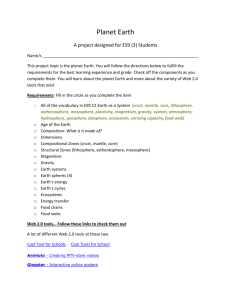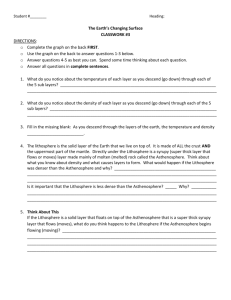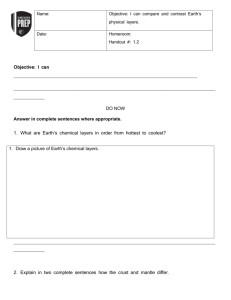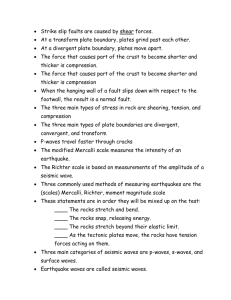File
advertisement
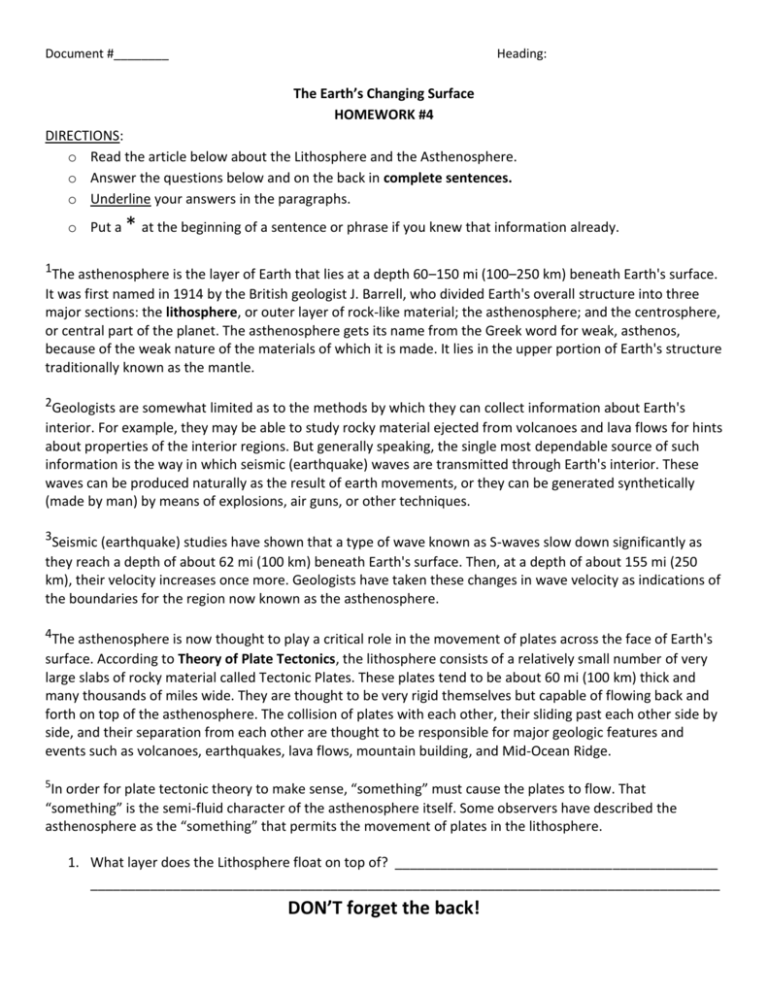
Document #________ Heading: The Earth’s Changing Surface HOMEWORK #4 DIRECTIONS: o Read the article below about the Lithosphere and the Asthenosphere. o Answer the questions below and on the back in complete sentences. o Underline your answers in the paragraphs. o Put a * at the beginning of a sentence or phrase if you knew that information already. 1The asthenosphere is the layer of Earth that lies at a depth 60–150 mi (100–250 km) beneath Earth's surface. It was first named in 1914 by the British geologist J. Barrell, who divided Earth's overall structure into three major sections: the lithosphere, or outer layer of rock-like material; the asthenosphere; and the centrosphere, or central part of the planet. The asthenosphere gets its name from the Greek word for weak, asthenos, because of the weak nature of the materials of which it is made. It lies in the upper portion of Earth's structure traditionally known as the mantle. 2Geologists are somewhat limited as to the methods by which they can collect information about Earth's interior. For example, they may be able to study rocky material ejected from volcanoes and lava flows for hints about properties of the interior regions. But generally speaking, the single most dependable source of such information is the way in which seismic (earthquake) waves are transmitted through Earth's interior. These waves can be produced naturally as the result of earth movements, or they can be generated synthetically (made by man) by means of explosions, air guns, or other techniques. 3Seismic (earthquake) studies have shown that a type of wave known as S-waves slow down significantly as they reach a depth of about 62 mi (100 km) beneath Earth's surface. Then, at a depth of about 155 mi (250 km), their velocity increases once more. Geologists have taken these changes in wave velocity as indications of the boundaries for the region now known as the asthenosphere. 4The asthenosphere is now thought to play a critical role in the movement of plates across the face of Earth's surface. According to Theory of Plate Tectonics, the lithosphere consists of a relatively small number of very large slabs of rocky material called Tectonic Plates. These plates tend to be about 60 mi (100 km) thick and many thousands of miles wide. They are thought to be very rigid themselves but capable of flowing back and forth on top of the asthenosphere. The collision of plates with each other, their sliding past each other side by side, and their separation from each other are thought to be responsible for major geologic features and events such as volcanoes, earthquakes, lava flows, mountain building, and Mid-Ocean Ridge. 5 In order for plate tectonic theory to make sense, “something” must cause the plates to flow. That “something” is the semi-fluid character of the asthenosphere itself. Some observers have described the asthenosphere as the “something” that permits the movement of plates in the lithosphere. 1. What layer does the Lithosphere float on top of? ___________________________________________ ____________________________________________________________________________________ DON’T forget the back! 2. What do scientists study or depend on to give them the information they need to study the inside of the earth? __________________________________________________________________________ 3. What do scientists call the small number of very large slabs (chunks) of rocky material the lithosphere is broken up into? ____________________________________________________________________ 4. Name the 5 major geological features and events the collision of “plates” are responsible for. HINT: See paragraph 4. _____________________________________________________________________ ____________________________________________________________________________________ 5. What is the “something” that allows the Lithosphere to move? ________________________________ SPIRALED REVIEW o Answer the questions below. 6. Examine the picture to the right. Which of the following is the correct order of the object’s/liquid’s density from least dense to densest? A. Chess Piece, Rock, Corn Syrup B. Rock, Corn Syrup, Chess Piece C. Chess Piece, Corn Syrup, Rock D. Corn Syrup, Chess Piece, Rock Explain your answer in at least 2 sentences. ____________________ _________________________________________________________ _________________________________________________________ _________________________________________________________ 7. The rock in the picture from question 6 has a mass of 35 g and a volume of 7 cm3. What is the rock’s density? Show your work, don’t forget your unit, AND circle your final answer! 8. Based on the density of the rock you calculated in question 7, which density below is most likely the density of the corn syrup? A. 7 g/mL C. 9 g/mL B. 3 g/mL D. 6 g/mL Explain your answer. __________________________________________________________________ ____________________________________________________________________________________ ____________________________________________________________________________________


